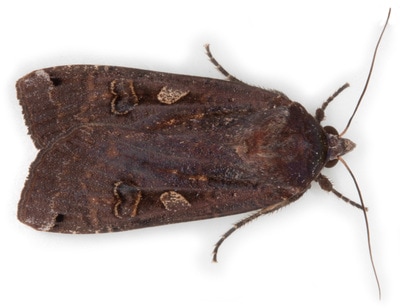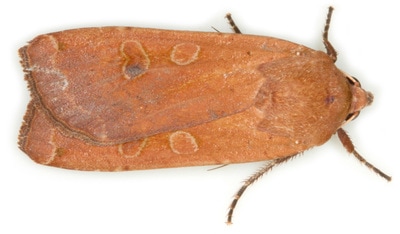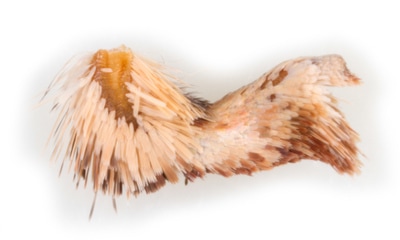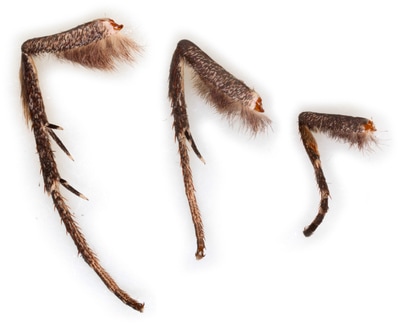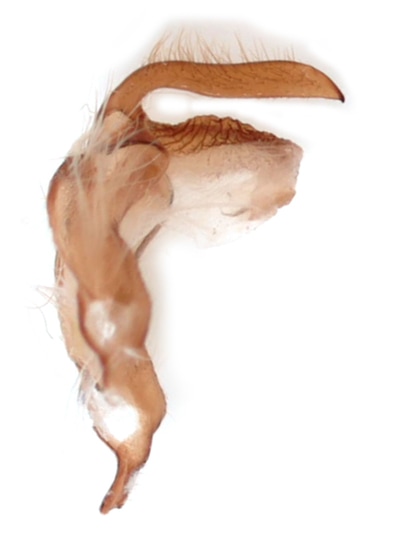73.342 Noctua pronuba (Large Yellow Underwing)
fw: 21-26mm (Waring & Townsend), 19.7-26.3mm (my specimens), ws 50-60mm (MBGBI9); Jun-Nov; various herbaceous plants and grasses; common resident and migrant throughout GB.
ID: Sexually dimorphic and polymorphic in both sexes. Generally recognisable in both sexes from size, elongate shape and 1 to 3 (usually 2) small black subcostal spots along the proximal margin of the subterminal line. Antenna finely setose in both sexes. Ground colour very variable - male: pale reddish-brown, through dark reddish-brown to blackish-brown, with or without a pale costal streak and variably marbled; female: uniform pale brown through reddish brown to brownish-grey, variably flecked with darker scales; oval and kidney mark obscure to well-marked - oval mark usually large, round, pale or pale-outlined - kindey mark usually darker than ground colour and pale-outlined - dart mark absent; hindwing bright yellow with a black subterminal fascia. MBGBI9 gives named forms as follows:
Male - ochreabrunnea - marbled brown with an ochreous costal streak from wing base to just distal to the oval mark;
Male - distinctacaerulescens - marbled brown with a grey costal streak;
Male - brunnea - uniformly reddish-brown;
Male - innuba - uniformly blackish-brown.
Female - ochrea - ocreous, flecked with brownish scales and with a contrastingly brown kidney mark;
Female - caerulescens - slaty-grey with a brown kidney mark;
Female - rufa - reddish-ochreous, usually with a darkened kidney mark.
There does seem to be a degree of overlap between some of these forms and there is not always a clear distinction between the "marbling" of males and the "flecking" of females. Some confusion is also engendered by the statement in MBGBI9 that "dark specimens are males, pale ones females", when compared with the illustrations in Waring and Townsend which show a dark female and a paler male. Nevertheless, I have made some attempt to ascribe the form to each of the specimens below, using a ? in cases of uncertainty. For the plainer forms a ? is also used to indicate that the sex was not confirmed other than by forewing features (distinctly marbled forms with a distinct costal streak should be clearly male).
N.orbona (Lunar Yellow Underwing) also shows the costal dash and a narrow black hindwing subterminal fascia, but is smaller (fw 17-20mm) and shows a central black hindwing crescent. All other Noctua species lack the subcostal spots on the subterminal line.
Male - ochreabrunnea - marbled brown with an ochreous costal streak from wing base to just distal to the oval mark;
Male - distinctacaerulescens - marbled brown with a grey costal streak;
Male - brunnea - uniformly reddish-brown;
Male - innuba - uniformly blackish-brown.
Female - ochrea - ocreous, flecked with brownish scales and with a contrastingly brown kidney mark;
Female - caerulescens - slaty-grey with a brown kidney mark;
Female - rufa - reddish-ochreous, usually with a darkened kidney mark.
There does seem to be a degree of overlap between some of these forms and there is not always a clear distinction between the "marbling" of males and the "flecking" of females. Some confusion is also engendered by the statement in MBGBI9 that "dark specimens are males, pale ones females", when compared with the illustrations in Waring and Townsend which show a dark female and a paler male. Nevertheless, I have made some attempt to ascribe the form to each of the specimens below, using a ? in cases of uncertainty. For the plainer forms a ? is also used to indicate that the sex was not confirmed other than by forewing features (distinctly marbled forms with a distinct costal streak should be clearly male).
N.orbona (Lunar Yellow Underwing) also shows the costal dash and a narrow black hindwing subterminal fascia, but is smaller (fw 17-20mm) and shows a central black hindwing crescent. All other Noctua species lack the subcostal spots on the subterminal line.
|
§1 Westcliff-on-sea, Essex; 21/05/2007; female? form ochrea?
§2 Westcliff-on-sea, Essex; 22/06/2007; male; form ochreabrunnea §3 Foulness, Essex; 23/06/2007; female? form ochrea §4 Foulness, Essex; 23/06/2007; male; form ochreabrunnea §5 Foulness, Essex; 30/06/2007; female? form ochrea §6 Westcliff-on-sea, Essex; 27/07/2007; male? form brunnea? §7 Foulness, Essex; 31/05/2008; female? form ochrea? §8 Westcliff-on-sea, Essex; 04/06/2008; fw 24.4mm; male? form? §9 Foulness, Essex; 28/06/2008; male; form ochreabrunnea §10 New Forest, Hampshire; 01/09/2013; female? form ochrea? §11 New Forest, Hampshire; 01/09/2013; male; form ochreabrunnea? §12 New Forest, Hampshire; 01/09/2013; female? form ochrea All images © Chris Lewis |
§13 St Lawrence, Isle of Wight; 31/05/2014; male? form innuba?
§14 St Lawrence, Isle of Wight; 31/05/2014; female? form rufa §15 Strumpshaw Fen, Norfolk; 25/07/2014; male? form innuba? §16 Foulness, Essex; 13/06/2015; female; fw 26.3mm; form ochrea §17 Foulness, Essex; 13/06/2015; male; fw 19.7mm; f ochreabrunnea §18 Somerton, Somerset; 18/06/2015; male? form brunnea? §19 Arne, Dorset; 05/07/2016; female? form rufa §20 St Marys, Isles of Scilly; 07/10/2019; male §21 St Marys, Isles of Scilly; 07/10/2019; female §22 Foulness, Essex; 12/09/2020; female |
Page published 15/03/2017 (§1-19) | §20&21 added 18/12/2019 | §22 added 24/12/2020








